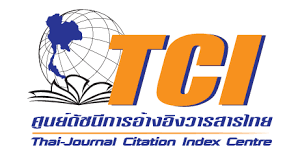MARKET POTENTIAL DEVELOPMENT BASED ON THE CONCEPT OF CREATIVE ECONOMY: WOVEN REED MAT COMMUNITY IN SILA LAT DISTRICT, SISAKET PROVINCE
Keywords:
Marketing Capability, Creative Economy, Woven Reed Mat Community Product, Market PotentialAbstract
This research aims to: 1) study the level of the community entrepreneurial knowledge based on the concept of creative economy; and 2) study the factors affect the development of market potential according to the creative economy concept of the woven reed community mat group in Sila Lat District, Sisaket Province. This research employs mixed methods research design, using structured in-depth interviews to synthesize the knowledge from seven representatives and using questionnaires to collect data from the woven reed community mat group in Sila Lat District, 77 people. The data were analyzed by using percentage, average, standard deviation, and multiple regression analysis. The results showed that there are five areas of knowledge based on the group's creative economy concepts: education and knowledge, creativity, intellectual property, technology and innovation, and culture. Overall, the average is high: In term of cultural aspect was the highest (= 4.07); followed by creative aspect (
= 3.97), education and Knowledge (
= 3.94), intellectual property (
= 3.93), and technology and Innovation (
= 3.89). In addition, the five areas of knowledge were contributing to the development of market potential based on the creative economy of the professional group by assisting them increase the availability and the distribution, requirement to continuous quality development of product, setting product sales prices according to increased sales volume, and marketing promotion, which attracts loyal customers to buy products continuously.
References
ขวัญกมล ดอนขวา. (2557). แบบจำลองของปรัชญาเศรษฐกิจพอเพียง และเศรษฐกิจสร้างสรรค์ที่มีผลต่อการพัฒนาเศรษฐกิจประเทศไทย. สำนักวิชาเทคโนโลยีสังคม มหาวิทยาลัยเทคโนโลยีสุรนารี.
จุฑาพรรธ์ ผดุงชีวิต. (2551). วัฒนธรรม การสื่อสารและอัตลักษณ์ : Culture, communication and identity. กรุงเทพฯ: สำนักพิมพ์แห่งจุฬาลงกรณ์มหาวิทยาลัย.
ดวงพร พุทธวงค์ และทรายทอง อุ่นนันกาศ. (2556). ความสำเร็จของการมีส่วนร่วมในการจัดกิจกรรมการท่องเที่ยวโดยชุมชน: กรณีศึกษาชุมชนถนนคนเดินกาดกองต้า จังหวัดลำปาง. วารสารปัญญาภิวัฒน์. 5(1), 1-16.
ณัฐวดี พัฒนโพธิ์. (2560). การพัฒนาศักยภาพกลุ่มแปรรูปผลิตภัณฑ์จากต้นกก บ้านโนนนาค ตำบลบัวบาน อำเภอยางตลาด จังหวัดกาฬสินธุ์. Governance Journal, 6(2), 120-132.
ณัฐวุฒิ พงศ์สิริ. (2552). การบริหารคนต่างรุ่นในองค์กร. (ออนไลน์). ค้นเมื่อวันที่ 17 มิถุนายน 2558. สืบค้นจาก http://www.hri.tu.ac.th/cms/seminardetail.aspx?tid=MTQx/.
พวงทอง วรรณีเวชศิลป์, กิตติวงค์ สาสวด, ศิริวัฒน์ จิระเดชประไพและ จรัสศรี หัวใจ. (2018). การพัฒนารูปแบบการบริหารธุรกิจกลุ่มอาชีพกระเป๋าสานเส้นพลาสติกตามแนวคิดเศรษฐกิจสร้างสรรค์ อำเภอพนมสารคาม จังหวัดฉะเชิงเทรา. ARU Research Journal, 5(2), 9-15.
พิทักษ์ น้อยวังคลัง. (2544). ลวดลายสาน. ภาควิชาทัศนศิลป์ มหาวิทยาลัยมหาสารคาม.
ยรรยง พวงราช. (2541). ทรัพย์สินทางปัญญา: ความหมาย ขอบเขต ความเป็นมาและความสำคัญ. วารสารบทบัณฑิตย์. 54, 18-34.
วรางคณา แสงทิพย์. (2557). นวัตกรรมและเทคโนโลยีสารสนเทศทางการศึกษา. ค้นคว้าเมื่อ 9 กรกฎาคม 2561, จาก http://warangkhana1307.blogspot.com/2014/09/blog-post.html.
วสันต์ วรเจริญ, ภัทรธิรา ผลงาม, จุลดิษฐ อุปฮาต และพยุงพร ศรีจันทวงษ์. (2561). การวิจัยและพัฒนาคุณภาพผลิตภัณฑ์วิสาหกิจชุมชนในกลุ่มทอเสื่อกก ตำบลคำไผ่ อำเภอไทยเจริญ จังหวัดยโสธร. สักทอง: วารสารมนุษยศาสตร์และสังคมศาสตร์ (สทมส.). 24, 55-68.
วิกรม วงษ์สุวรรณ์, พลเดช เชาวรัตน์, ชัญญา ทองสวัสดี, วิชนาถ ทิวะสิงห์, ฐติรัตน์ นิมิตบรรณสาร และ อภิเชษฐ์ ตีคลี. (2561). โครงการถ่ายทอดเทคโนโลยีเพื่อพัฒนาผลิตภัณฑ์ Premium OTOP เสื่อกก จังหวัดมหาสารคาม. คณะสถาปัตยกรรมศาสตร์ ผังเมืองและนฤมิตศิลป์ มหาวิทยาลัยมหาสารคาม. 1-2.
ศุภชัย เหมือนโพธิ์ และ ธีรศักดิ์ อุ่นอารมณ์เลิศ. (2561). การพัฒนาศักยภาพผู้ประกอบการชุมชน ตามแนวคิดเศรษฐกิจสร้างสรรค์. วารสารศิลปากรศึกษาศาสตร์วิจัย. 10(1), 131-144.
ศรินทร์ ขันติวัฒนะกุล. (2558). ปัญหาและแนวทางการพัฒนาการของผลิตภัณฑ์ของกลุ่มอาชีพในเขตจตุจักรเพื่อการพัฒนาธุรกิจอย่างยั่งยืน. วารสารบริหารธุรกิจศรีนครินทรโรฒ. 6(1), 69-81.
สุชาติ จรประดิษฐ์. (2557). อิทธิพลของการใช้แนวคิดเศรษฐกิจสร้างสรรค์ ปัจจัยขับเคลื่อนเศรษฐกิจสร้างสรรค์ และคุณลักษณะของผู้ประกอบการที่มีต่อความสำเร็จทางการตลาดของสินค้าหนึ่งตำบลหนึ่งผลิตภัณฑ์ (โอทอป) ระดับ 5 ดาว ในประเทศไทย. วิทยานิพนธ์บริหารธุรกิจดุษฎีบัณฑิต คณะบริหารธุรกิจ มหาวิทยาลัยธุรกิจบัณฑิตย์: กรุงเทพฯ.
สุชาติ จรประดิษฐ์,อดิลล่า พงศ์ยี่หล้า และเสริมศักดิ์ วิศาลาภรณ์. (2557). อิทธิพลของการใช้แนวคิดเศรษฐกิจสร้างสรรค์ ปัจจัยขับเคลื่อนเศรษฐกิจสร้างสรรค์ และคุณลักษณะของผู้ประกอบการที่มีต่อความสำเร็จทางการตลาดของสินค้าหนึ่งตำบลหนึ่งผลิตภัณฑ์ (OTOP) ระดับ 5 ดาว ในประเทศไทย. วารสาร
สุทธิปริทัศน์. 28(88), 171-195.
สำนักงานพัฒนาชุมชนอำเภอศิลาลาดจังหวัดศรีสะเกษ. (2561). ฐานข้อมูลกลุ่มผู้ลงทะเบียน ปี 2558. (ออนไลน์). ค้นเมื่อวันที่ 29 สิงหาคม 2561. สืบค้นจาก http://district.cdd.go.th/silalat/
สำนักงานคณะกรรมการพัฒนาการเศรษฐกิจและสังคมแห่งชาติ. (2552). รายงานประจำปี 2552. กรุงเทพฯ: คณะกรรมการพัฒนาการเศรษฐกิจและสังคมแห่งชาติ.
อาคม เติมพิทยาไพสิฐ. (2561). Thailand’s Creative Economy. (ออนไลน์). เข้าถึงได้จาก:http://www.nesdb.go.th/nesdb_en/ewt_w3c/ewt_dl_link.php?nid=4174,2553. (วันที่ค้นข้อมูล: 29 สิงหาคม 2561).
อรสา จูภัทรธนากุล. (2551). ความสัมพันธ์ระหว่างบุคลิกภาพมิติสร้างสรรค์ พฤติกรรมการเผชิญปัญหากับ ผลการปฏิบัติงาน: กรณีศึกษาโรงพยาบาลสังกัดรัฐวิสาหกิจแห่งหนึ่ง. วิทยานิพนธ์ปริญญา มหาบัณฑิต สาขาวิชาจิตวิทยาอุตสาหกรรมและองค์การ คณะศิลปะศาสตร์ มหาวิทยาลัยธรรมศาสตร์ :กรุงเทพฯ.
อัญชลี ครุธงาม. (2558). การพัฒนาหลักสูตรงานประดิษฐ์ผลิตภัณฑ์จากผ้าทอคูบัวตามแนวคิดเศรษฐกิจสร้างสรรค์สำหรับชั้นมัธยมศึกษาปีที่ 1. Viridian E-Journal, Silpakorn Univesity. 8(2), 352-371.
Barney, Jay. (1991). Firm resources and sustained competitive advantage. Journal of management. 17(1), 99-120.
Eisenhardt, K.M. & Martin, J.A. (2000). Dynamic Capabilities: What are they?. Strategic Management Journal. 21 (10/11), 1105.
Froehle, C. M., A. V. Roth, R. B. Chase, C. A. Voss. (2000). Antecedents of new service development effectiveness: An exploratory examination of strategic operations choices. Journal of Service Research, 3(1), 3-17.
Griffith, D. A., Yalcinkaya, G., & Calantone, R. J. (2010). Do marketing capabilities consistently media effects of firm intangible capital on performance across institutional environments? Journal of World Business, 45, 217-227.
Guenzi, P. & Troilo, G. (2006). Developing marketing capabilities for customer value Creation through Market Sales integration. Industrial Marketing Management. 35,974-988.
Hair, J.F., Jr., Black, W. C., Babin, B. J., Anderson, R. E. & Tatham, R.L.(2006). Multivariate data analysis (6thed.). Upper Saddle River, NJ: Prentice-Hall.
Howkins, John. (2001). The Creative Economy. The Penguin Press.
Kaleka, A. (2002). Resources and capabilities driving competitive advantage in export
markets: Guidelines for industrial exporters. Industrial Marketing Management. 31 (3),
-283.
Knight. (2000). Entrepreneurship and marketing strategy: The SME under globalization. Journal of international marketing, 8(2), 12-32.
Kotler, P. (2003). Marketing management. New Jersey: Prentice-Hall.
Kotler, P. & Armstrong, G. (2004). Principles of Marketing. 10th Edition, Pearson-Prentice Hall, New Jersey.
MacKinnon, Donald W. (1962). The Nature and Nurture of Creative Thinkingé. American Psychologist. 17(7), 484-495.
Marsella, A.J. (1989). Culture and mental health: an overview. In A. J. Marsella and G.M. White (eds), Cultural Conceptions of Mental Health and Therapy. Dordrecht: D.Reidel Publishing Company, 359-388.
Miller. V. A. (1994). The Guidebook for Global Trainers. Massachusetts: Human Resource Development. Press, Inc.
Morgan, D. L., & Scannell, A. U. (1998). Planning focus group. In D. L. Morgan, R. A. Kruger & J. A. King (Eds.), Focus group kits, 2. Thousand Oaks, CA: Sage.
Morgan, N.A., Kaleka, A., and Katsikeas, C.S. (2004). Antecedents of Export venture performance: A theoretical model and empirical assessment. Journal of Marketing. 68(1), 90.
Saleh M, A. A. (2015). The role of marketing capabilities in firm's success. International. Journal of Management Science and Business Administration. 2(1), 56-65.
Shamsuddoha, A.K., and Ali, M.Y. (2006). Mediated effects of export promotion programs on firm export performance. Asia Pacific Journal of Marketing and Logistics. 18 (2), 93.
Tsai, M.-T. & Shih, C.-M. (2004). The impact of marketing knowledge among managers on Marketing capabilities and business performance. International Journal of Management. 21(4), 524.
UNCTAD. (2008). Creative Economy Report 2008. Geneva: UNCTAD.






